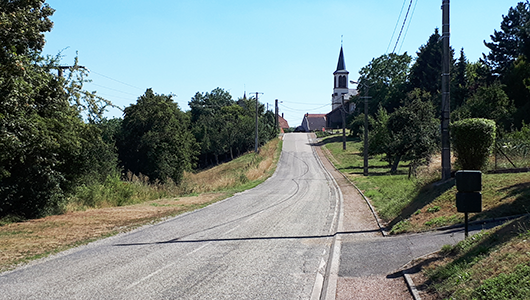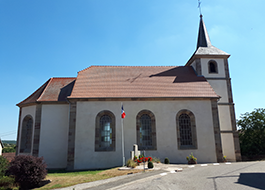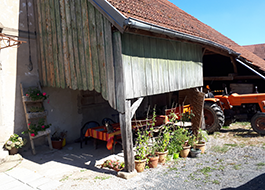Hellering-lès-Fénétrange
Durée visite : 30 minutes
Moyen : Pédestre
Au XVIIe siècle, le village dépendait de la principauté de Phalsbourg et Lixheim. Celle-ci était une éphémère principauté, faisant partie du Saint-Empire romain germanique. Elle fut créée en 1629 et dissoute en 1702. Elle récompensait les services rendus par Louis de Guise, époux d’Henriette, fille du duc de Lorraine, à l’empereur Ferdinand. Henriette et ses trois époux successifs portèrent le titre de princes de Phalsbourg. Le troisième mari, François Grimaldi, apparenté à la famille de Monaco, mourut sans postérité. Ses terres revinrent au duché de Lorraine.
In the 17th century, the village depended on the principality of Phalsbourg and Lixheim. It was an ephemeral principality, part of the Holy Roman Empire. It was created in 1629 and dissolved in 1702. She rewarded the services rendered by Louis de Guise, husband of Henriette, daughter of the Duke of Lorraine, to Emperor Ferdinand. Henriette and her three successive husbands were the princes of Phalsbourg. The third husband, François Grimaldi, related to the family of Monaco, died without posterity. His lands returned to the Duchy of Lorraine.
Im 17. Jahrhundert war das Dorf vom Fürstentum Phalsburg und Lixheim abhängig. Es war ein kurzlebiges Fürstentum, teil des Heiligen Römischen Reiches. Sie wurde 1629 gegründet und 1702 aufgelöst. Sie belohnte die Dienste von Louis de Guise, dem Ehemann von Henriette, Tochter des Herzogs von Lothringen, an Kaiser Ferdinand. Henriette und ihre drei aufeinanderfolgenden Eheleute trugen den Titel « Prinzen von Phalsburg ». Der dritte Ehemann, François Grimaldi, verwandt mit der Familie von Monaco, starb ohne Nachkommen. Sein Land kehrte zum Lothringer Duschland zurück.

D’argent à la croix pattée de sable, au chapé d’azur chargé de deux roses d’or.
Les roses rappellent l’appartenance à la principauté de Lixheim. La croix de l’Ordre teutonique indique que la commanderie de Sarrebourg avait des biens dans la localité.
Silver to the cross pated with sand, to the capé of azure laden with two gold roses.
The roses are a reminder of belonging to the principality of Lixheim. The cross of the Teutonic Order indicates that the Commandery of Sarrebourg had property in the town.
Von Silber zum Sandkreuz, zu dem mit zwei goldenen Rosen beladenen blaufarbenen Gemusterten.
Die Rosen erinnern an die Zugehörigkeit zum Fürstentum Lixheim. Das Kreuz des teutonischen Ordens weist darauf hin, dass die Saarburger Kommandion Eigentum in der Ortschaft hatte.

Les habitants d’Hellering-les-Fénétrange s’appellent les Helleringeois et les Helleringeoises.
The inhabitants of Hellering-les-Fénét Strange are called the Helleringeois and the Helleringeoises.
Die Einwohner von Hellering-les-Fénétrange heißen helleringeois und helleringeoises.
Les points de visites
.
En 1556, en application du principe cujus regio ejus religio, Hellering devient protestant, en raison de son appartenance au territoire de Lixheim, détenu par le prince palatin Otto-Heinrich de Pflaz-Neuburg. D’abord luthérien, il passa peu après au calvinisme. L’intégration au duché de Lorraine en 1623 conduisit les protestants à se rendre au culte hors la commune alors que l’église fut transmise aux catholiques. C’est pour la communauté catholique que fut construite en 1786, au centre du village, une église qui fut érigée par décret napoléonien en simultaneum en 1807 : un seul lieu pour deux confessions religieuses qui se succèdent, selon un horaire et un mode d’usage fixé du chœur et du mobilier. Le premier cadastre, daté de 1812, montre un édifice entouré d’un cimetière aujourd’hui disparu, avec une sacristie au sud. En raison de conflits incessants entre les deux communautés, le simultaneum fut arrêté en 1872 et une nouvelle église néo-gothique fut construite. Les catholiques eurent dès lors une église spécifique, l’église Saint-Martin de style néo-gothique. Les deux autels latéraux de la nouvelle église pourraient provenir de l’ancienne église (l’un dédié à saint Roch, l’autre à la Vierge), actuel temple. L’aménagement intérieur de l’édifice le plus ancien, désormais dédié au culte calviniste, a dès lors était modifié avec installation d’une nouvelle cloche (1880), de l’orgue en fond de chœur (1909), de la table de Sainte-Cène (1881) et d’une plaque commémorative des morts de la première guerre mondiale en pendant. La chaire pourrait en revanche être l’ancienne déplacée et modifiée, notamment dans sa partie supérieure.
In 1556, under the principle of cujus regio ejus religio, Hellering became a Protestant, because of his membership in the territory of Lixheim, owned by the Palatine Prince Otto-Heinrich of Pflaz-Neuburg. First Lutheran, he soon moved on to Calvinism. The integration into the Duchy of Lorraine in 1623 led Protestants to go to worship outside the commune while the church was handed over to Catholics. It was for the Catholic community that in 1786, in the centre of the village, a church was built, which was erected by Napoleonic decree in simultaneum in 1807: a single place for two successive religious denominations, according to a schedule and a fixed mode of use of the choir and furniture. The first land registry dated 1812 shows a building surrounded by a cemetery that has now disappeared, with a sacristy to the south. Due to ongoing conflicts between the two communities, the simultaneum was stopped in 1872 and a new neo-Gothic church was built. From then on, Catholics had a specific church, the Church of St. Martin in the neo-Gothic style. The two side altars of the new church could come from the old church (one dedicated to St. Roch, the other to the Virgin), present-day temple. The interior layout of the oldest building, now dedicated to Calvinist worship, was then modified with the installation of a new bell (1880), the organ in the back of the choir (1909), the sacrament table (1881) and a plaque commemorating the dead of the First World War in hanging. The pulpit, on the other hand, could be the old one, which is moved and modified, especially in its upper part.
Im Jahr 1556, in Anwendung des Prinzips cujus regio ejus religio, hellering wurde protestantisch, wegen seiner Zugehörigkeit zum Gebiet von Lixheim, im Besitz von Palatin Prinz Otto-Heinrich von Pflaz-Neuburg. Zuerst lutherisch, ging er kurz darauf zum Calvinismus über. Die Integration in das Dutum Lothringen im Jahr 1623 führte die Protestanten zum Gottesdienst außerhalb der Gemeinde, während die Kirche an die Katholiken weitergegeben wurde. Für die katholische Gemeinde wurde 1786 im Dorfzentrum eine Kirche erbaut, die 1807 durch napoleonisches Dekret im Simultaneum errichtet wurde: ein einziger Ort für zwei aufeinanderfolgende religiöse Konfessionen, nach einem festgelegten Zeitplan und einer bestimmten Art der Benutzung des Chors und der Möbel. Das erste Kataster aus dem Jahr 1812 zeigt ein Gebäude, das von einem heute verschwundenen Friedhof umgeben ist, mit einer Sakristei im Süden. Aufgrund der ständigen Konflikte zwischen den beiden Gemeinden wurde das Simultaneum 1872 eingestellt und eine neue neugotische Kirche errichtet. Die Katholiken hatten daher eine besondere Kirche, die Kirche St. Martin im neugotischen Stil. Die beiden Seitenaltäre der neuen Kirche könnten aus der alten Kirche stammen (der eine ist dem heiligen Roch gewidmet, der andere der Jungfrau), dem heutigen Tempel. Die Inneneinrichtung des ältesten Gebäudes, das nun dem calvinistischen Kult gewidmet ist, wurde daher mit einer neuen Glocke (1880), der Orgel im Chorhintergrund (1909), dem Tisch des Abendmahls (1881) und einer Gedenktafel für die Toten des ersten Weltkriegs in der Zwischenzeit geändert. Der Lehrstuhl könnte jedoch die alte verschoben und geändert werden, vor allem im oberen Bereich.
.
Cette ferme encore en activité présente un appentis en bois. Outre son effet protecteur contre les intempéries pour le bâtiment, il permet le stockage de bois, de foin ou d’outils. Cette construction est typique de la région.
The presbytery and its outbuildings were built in 1755, following in the footsteps of St. Remy’s Church.
This farm still in operation has a wooden lean-to. In addition to its weather-fighting protection effect for the building, it allows the storage of wood, hay or tools. This construction is typical of the region.
Dieser noch in Betrieb bebaute Bauernhof hat einen hölzernen Schnitzstoff. Neben seiner wetterfesten Wirkung für das Gebäude ermöglicht es die Lagerung von Holz, Heu oder Werkzeug. Diese Konstruktion ist typisch für die Region.
.
Le poids public est utilisé dans le commerce ou le transport pour évaluer le poids de marchandises ou la tare d’un véhicule. En France, la plupart des poids publics sont installés au début du 19e siècle. C’est l’époque où se développe le nouveau système des poids et mesures, issu de la Révolution. Celui-ci permet de diminuer les fraudes, dues aux différents systèmes en vigueur auparavant. Leur utilisation est devenue désuète au 20e siècle.
The public weight is used in trade or transport to assess the weight of goods or the defect of a vehicle. In France, most public weights were installed at the beginning of the 19th century. This was the time when the new system of weights and measures, born of the Revolution, developed. This reduces fraud, due to the various systems in place previously. Their use became obsolete in the 20th century.
Das öffentliche Gewicht wird im Handel oder in der Beförderung verwendet, um das Gewicht der Güter oder die Wäge eines Fahrzeugs zu bewerten. In Frankreich wurden die meisten öffentlichen Gewichte zu Beginn des 19. Jahrhunderts installiert. Es ist die Zeit, in der sich das neue System der Gewichte und Maße entwickelt, das aus der Revolution hervorgegangen ist. Dies ermöglicht eine Verringerung der Betrugsfälle, die auf die verschiedenen zuvor geltenden Systeme zurückgehen. Ihre Verwendung wurde im 20. Jahrhundert veraltet.
.
L’église saint-Martin date de 1877. Elle fut construite aux frais de Mgr Dupont des Loges, évêque de Metz. Il voulait mettre fin au simultanéum. En effet depuis un décret napoléonien, l’église était partagée par les réformés et les catholiques. Ceux-ci ne jouissaient que du chœur. Le prélat n’acceptait pas cette exception en Moselle. Il l’a jugeait contraire aux lois canoniques et civiles. En style néo-gothique, elle allie finesse et élancement. Ces caractères sont accentués par une récente restauration.
St. Martin’s Church dates back to 1877. It was built at the expense of Bishop Dupont des Loges, Bishop of Metz. He wanted to end the simultaneous. Indeed, since a Napoleonic decree, the church was shared by the Reformed and Catholics. They only enjoyed the choir. The prelate did not accept this exception in Moselle. He found it contrary to canonical and civil laws. In neo-Gothic style, it combines finesse and slenderness. These characters are accentuated by a recent restoration.
Die St. Martin-Kirche stammt aus dem Jahr 1877. Sie wurde auf Kosten von Msgr. Dupont des Loges, Bischof von Metz, erbaut. Er wollte das Simultaneum beenden. In der Tat seit einem napoleonischen Dekret, wurde die Kirche von den Reformierten und Katholiken geteilt. Diese genossen nur den Chor. Der Prälat akzeptierte diese Ausnahme in der Mosel nicht. Er hielt es für gegen die Kirchen- und Zivilgesetze. Im neugotischen Stil verbindet sie Feinheit und Schwung. Diese Merkmale werden durch eine kürzliche Restaurierung verstärkt.
.









